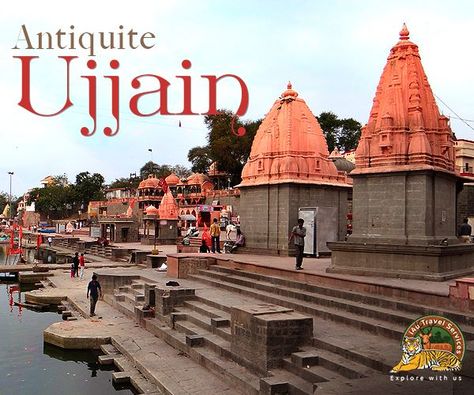The early history of Ujjain is lost in the midst of antiquity. As early as the time of the Aryan settlers, Ujjain seems to have acquired importance. By the 6th century B.C. Avanti with its capital at Ujjaini, is mentioned in Buddhist literature as one of the four great powers along with Vatsa, Kosala and Magadha.
The ancient city of Ujjain lies on the banks of the holy River Shipra, a tributary of the Chambal. It is popularly held that the number of temples in Ujjain is so large that if a pilgrim comes here with two cartloads of grain and offers only one handful at each temple, he/she would still run short of offerings. Ujjain lay on the main trade route between North India and Deccan going from Mathura via Ujjain to Mahismati (Maheshwar) on the Narmada, and on to Paithan on the Godavari, western Asia and today, Ujjain abounds in temples, hoary old tradition attached to each of them. But though most of them have been built upon sites of antiquity, none of them has survived in the original splendour. Desecrated and despoiled time and time again, the structures that stand today are of more recent date, renovated or rebuilt over the years. And yet, the temples form an integral part of the city and contribute to the continuity of Ujjain’s tradition of greatness. One of the 12 jyotirlingas in India, the lingam at the Mahakal is believed to be swayambhu (born of itself) deriving currents of power (shakti) from within itself as against the other images and lingams which are ritually established and invested with mantra-shakti. The idol of Mahakaleshwar is known to be Dakshinamurti, facing the south. This is a unique feature upheld by tantric traditions to be found only in Mahakaleshwar among the 12 Jyotirlingas. The idol of Omkareshwar Shiva is consecrated in the sanctum above the Mahakal shrine the west.
The five-day Panchakoshi Yatra is an annual journey that pilgrims undertake. This involves a visit to the 84 Shiva temples in Ujjain. Also known as the Chardwar Yatra (journey of the four gates), it includes a visit to the sites that mark the four mythological gates of Ujjain. When Parvati chose to perform her penance in Ujjain, Shiva raised a wall around the town with a gate facing each cardinal direction. Each was guarded by a deity – Pingaleshwar (east), Bilveshwar (west), Kayavarohaneshwar (south) and Dardureshwar (north). The temples dedicated to them exist to this day.


The village of Bhairogarh (across the River Shipra) was once famous for its tie-and-dye printing. At the height of its glory, when Ujjain was connected with the ports of Gujarat, fabric from Bharigarh would find its way to places such as Rome and China. Even today, you can walk into one of the printers houses and pick up brightly coloured bedspreads at quite a bargain.

Ujjain is rich in mythology & legends

Ujjain has elaborate mentions in the historical books & was a centre of advanced science, spirituality & literature.

The Mathematics connection to Ujjain, In ancient times, Ujjain was an important centre of astronomy, mathematics and arithmetical operations.

The Kumbh Mela or the Simhastha Kumbh at Ujjain, held once every 12 years is a truely devine experience.

Ujjain, the spiritual Capital of Madhya Pradesh is the centre of religious tourism in Madhya Pradesh. Feel blessed when you visit the temples & the ghats.
i4u Travel Services is an one stop shop to fulfill all your travel needs for Madhya Pradesh tour.
Let i4u Travel Services be your Madhya Pradesh Tour Guide to showcase the Best of Madhya Pradesh.
As a reliable travel agency for Madhya Pradesh tour, we offer our services in :
Leave your name and email below along with what you are looking for in the message box. Or you can call us at +91 94251 57188
WhatsApp us